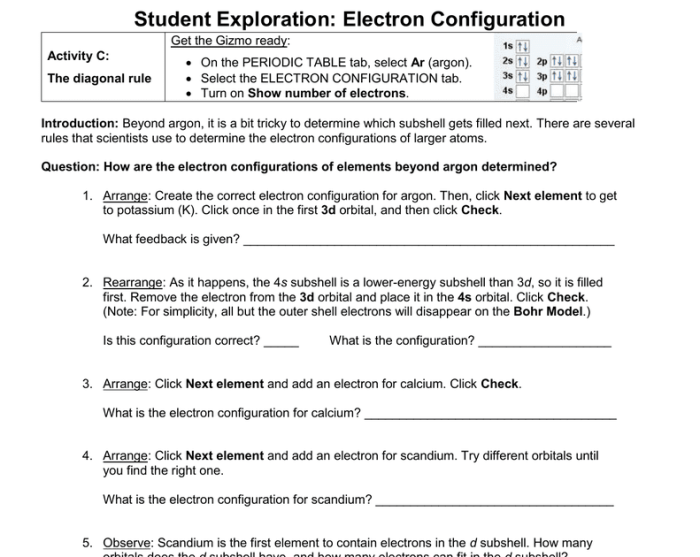The student exploration periodic trends gizmo answer key pdf is an invaluable resource for students seeking to delve into the intricacies of periodic trends and their applications. This comprehensive guide provides a thorough overview of the concept, utilizing the Student Exploration Gizmo to facilitate interactive learning and exploration.
The Gizmo allows users to manipulate elements on the periodic table, observe their properties, and analyze the relationships between atomic number and various periodic trends. This hands-on approach deepens understanding and fosters a genuine appreciation for the subject matter.
Periodic Trends
Periodic trends are patterns in the properties of elements that can be observed when the elements are arranged in order of their atomic number. These trends can be used to predict the properties of an element based on its position in the periodic table.Some
of the most common periodic trends include:
- Atomic radius: The atomic radius of an element is the distance from the nucleus to the outermost electron shell. The atomic radius generally decreases across a period (row) of the periodic table and increases down a group (column).
- Ionization energy: The ionization energy of an element is the amount of energy required to remove an electron from the atom. Ionization energy generally increases across a period and decreases down a group.
- Electron affinity: The electron affinity of an element is the amount of energy released when an electron is added to the atom. Electron affinity generally increases across a period and decreases down a group.
- Electronegativity: The electronegativity of an element is a measure of its ability to attract electrons. Electronegativity generally increases across a period and decreases down a group.
These are just a few of the many periodic trends that have been observed. Periodic trends can be used to predict the properties of elements, and they can also be used to explain the behavior of elements in chemical reactions.
Student Exploration Gizmo: Student Exploration Periodic Trends Gizmo Answer Key Pdf

The Student Exploration Gizmo is a virtual laboratory that allows students to explore periodic trends. The Gizmo includes a periodic table, as well as a variety of tools that can be used to investigate the properties of elements.To use the Gizmo to explore periodic trends, students can select an element from the periodic table.
The Gizmo will then display a variety of information about the element, including its atomic number, atomic mass, and electron configuration. Students can also use the Gizmo to plot the element’s properties on a graph.The Gizmo can be used to explore a variety of periodic trends.
For example, students can use the Gizmo to investigate the relationship between atomic number and atomic radius. Students can also use the Gizmo to investigate the relationship between ionization energy and electronegativity.The Gizmo is a valuable tool for students who are learning about periodic trends.
The Gizmo can help students to visualize periodic trends and to understand the relationship between the properties of elements and their position in the periodic table.
Answer Key

The following is an answer key for the Gizmo activities: Activity 1: Exploring the Periodic Table
- Question:What is the atomic number of the element with the symbol Na? Answer:11
- Question:What is the atomic mass of the element with the symbol Cl? Answer:35.45
- Question:What is the electron configuration of the element with the symbol O? Answer:1s 22s 22p 4
Activity 2: Plotting Periodic Trends
- Question:What is the relationship between atomic number and atomic radius? Answer:Atomic radius generally decreases across a period and increases down a group.
- Question:What is the relationship between ionization energy and electronegativity? Answer:Ionization energy generally increases across a period and decreases down a group. Electronegativity generally increases across a period and decreases down a group.
Applications of Periodic Trends
Periodic trends can be used to predict the properties of elements, and they can also be used to explain the behavior of elements in chemical reactions. For example, periodic trends can be used to:
- Predict the reactivity of an element.
- Predict the type of chemical bond that an element will form.
- Explain the behavior of elements in different chemical reactions.
Periodic trends are also important in a variety of fields of science, including chemistry, physics, and biology. For example, periodic trends can be used to:
- Design new materials with specific properties.
- Develop new drugs and treatments for diseases.
- Understand the behavior of elements in the environment.
Periodic trends are a powerful tool that can be used to understand the properties of elements and their behavior in chemical reactions. Periodic trends are also important in a variety of fields of science, and they can be used to solve a variety of problems.
Quick FAQs
What is the purpose of the student exploration periodic trends gizmo?
The gizmo is designed to help students explore periodic trends and their relationships with atomic number and various element properties.
How can I access the student exploration periodic trends gizmo answer key pdf?
The answer key is typically provided by the teacher or instructor as part of the course materials.
What are some common misconceptions about periodic trends?
Some common misconceptions include believing that all elements in a group have identical properties or that the periodic table is arranged in a linear fashion.